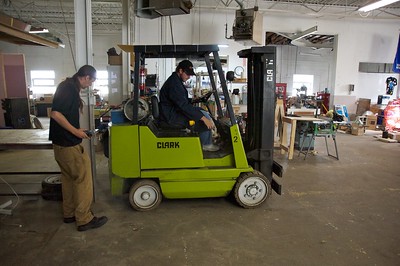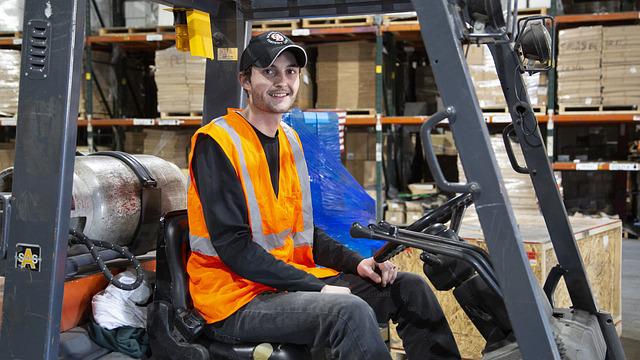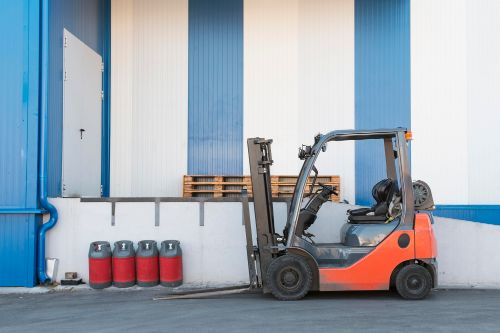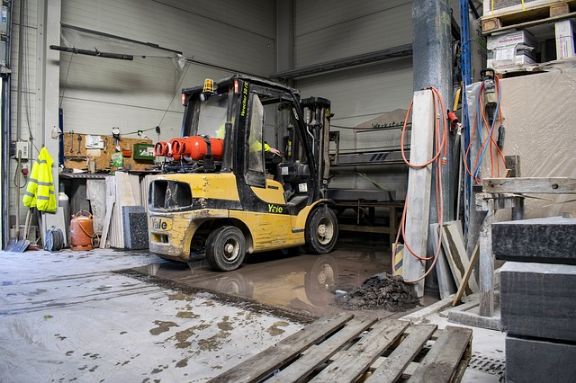
Choosing the correct propane forklift tank is not just about ensuring that your forklift operates effectively; it’s about safety, efficiency, longevity, and cost-effectiveness. Forklifts are often used in environments where safety is paramount, such as warehouses, docks, and construction sites. An incorrect or inadequate tank can pose serious safety risks, lead to operational inefficiencies, and result in additional costs over time.
The propane tank acts as the energy source for the forklift. If it’s not designed to work harmoniously with the specific model of the forklift, the machine might not operate at peak performance. This can result in reduced work output and increased downtime. Moreover, a malfunctioning or incompatible tank can lead to propane leaks, which are not only wasteful but also pose a significant safety hazard.
In addition, investing in the right propane tank ensures that the equipment will have a longer operational lifespan. It reduces wear and tear on the forklift’s systems, ensuring that maintenance costs are minimized and the machine remains operational for longer periods.
Key Considerations to Keep in Mind:
- Tank Specifications: Always check the tank’s material, build quality, and specifications to ensure it can withstand the rigors of daily use.
- Capacity and Size: Consider how long you expect the forklift to operate between refills. A larger tank provides longer operational hours but might be heavier and bulkier.
- Safety Features: Ensure that the tank has essential safety mechanisms like pressure relief devices and overfill prevention systems.
- Compatibility: Not all tanks fit all forklifts. It’s crucial to ensure that the tank is compatible with your forklift model in terms of attachment mechanisms and stability.
- Operational Environment: Consider where the forklift will be used. Tanks might need additional protective features if used in extreme climates or challenging conditions.
- Emission Standards: Depending on your region, there might be strict emission standards in place. Ensure your tank and forklift combination meets these standards.
- Refilling and Storage: Consider the ease with which the tank can be refilled and stored. A tank that’s difficult to refill can hamper operations, especially in busy environments.
- Advanced Features: Depending on your needs, you might want to invest in tanks with integrated gauges, monitoring systems, or other advanced features that improve operation and safety.
By focusing on these key considerations, one can ensure that they’re investing in a propane forklift tank that not only meets their immediate needs but also ensures long-term safety and operational efficiency.
Material and Build of Forklift Propane Tank
The material and build quality of a propane forklift tank play crucial roles in determining its durability, safety, and performance. Choosing the right construction ensures the tank can withstand daily use, potential impacts, and varying environmental conditions while safely storing and delivering propane to the forklift.
Different Materials Used in Tank Construction and Their Implications:
- Steel:
- Properties: Durable, robust, and has high tensile strength.
- Implications: Steel tanks are often the standard in the industry due to their resilience and ability to handle high pressures. However, they can be prone to rust if not properly treated or painted, especially in humid or salty environments.
- Aluminum:
- Properties: Lightweight, corrosion-resistant, and has good thermal conductivity.
- Implications: Aluminum tanks are less heavy than their steel counterparts, making them easier to transport and handle. Their resistance to corrosion makes them ideal for marine or coastal applications. However, they might not handle extremely high pressures as well as steel.
- Composite Materials:
- Properties: Can consist of a blend of materials like fiberglass and plastics.
- Implications: Composite tanks are even lighter than aluminum, reducing the overall weight of the forklift. They are also resistant to corrosion and have a clearer indication of fuel level due to their translucency. However, they may not have the same longevity as metal tanks.
Importance of Tank Wall Thickness and Structural Integrity:
- Pressure Handling: Propane is stored under pressure, and the tank’s wall thickness directly impacts its ability to safely contain the gas. A thicker wall can generally handle higher pressures, ensuring that the propane remains safely stored even under varying temperatures and conditions.
- Durability and Longevity: Tanks with appropriate wall thickness are less susceptible to dents, punctures, and other forms of damage. This not only ensures a longer tank lifespan but also reduces the chances of dangerous propane leaks.
- Safety: A structurally sound tank, with the right wall thickness, minimizes the risk of explosions or ruptures. Even minor damage or deformities in a tank can lead to weak points where the tank might fail under pressure.
- Weight and Balance: While a thicker wall provides more structural integrity, it also adds to the tank’s weight. It’s essential to strike a balance between wall thickness and the overall weight to ensure that the forklift’s stability and maneuverability aren’t compromised.
The material and build quality of a propane forklift tank are of utmost importance. They directly impact the tank’s safety, performance, and longevity. When selecting a tank, it’s essential to consider the specific requirements of the operation and environment to ensure optimal performance and safety.
Capacity and Size Are Significant Considerations When Choosing
Capacity and size are fundamental considerations when selecting a propane forklift tank. These factors influence the forklift’s operational duration, efficiency, and maneuverability within a workspace. Making an informed choice ensures optimal performance and safety during operations.
Understanding the Weight of Propane:
- Density: Propane has a density of around 0.493 grams per cubic centimeter (g/cm³) at 25°C. However, it’s stored in tanks as a liquid under pressure.
- Weight-to-Volume Ratio: One gallon of liquid propane weighs approximately 4.23 pounds (1.92 kilograms). This weight-to-volume ratio helps in estimating how much a filled tank will weigh, aiding in proper handling and installation.
- Tare Weight vs. Full Weight: The tare weight of a tank refers to its weight when empty, while the full weight includes the weight of the propane. Always consider the full weight when evaluating the potential impact on the forklift’s load-bearing capabilities.
How Tank Size Relates to Operation Hours and Work Efficiency:
- Operational Duration: A larger tank can store more propane, allowing the forklift to operate for extended periods without needing a refill. This can be especially beneficial in continuous operation environments where downtime can be costly.
- Refill Frequency: While a larger tank reduces the frequency of refills, it also means that when refills are necessary, they might take longer and be more cumbersome due to the increased volume of propane.
- Efficiency Considerations: Constantly changing or refilling tanks can interrupt workflow and reduce overall operational efficiency. Choosing the right tank size ensures a balance between operation hours and refill intervals.
While the capacity and size of a propane forklift tank are directly related to its operational duration, it’s vital to balance these factors with workspace constraints, maneuverability, and the forklift’s overall performance. Properly gauging operational needs against these considerations will lead to a more efficient and safer work environment.
Safety Features in Propane Forklift Tanks
Safety is paramount when dealing with propane tanks due to the potential hazards associated with gas leaks, overfilling, or tank explosions. Several safety features are integrated into these tanks to minimize risks and ensure safe operation.
- Pressure Relief Devices and Their Significance:
- Function: These devices automatically release propane if the pressure inside the tank exceeds safe levels, which can occur due to external factors like temperature increases.
- Significance: Without pressure relief, tanks can rupture or explode due to over-pressurization, leading to significant damage, injuries, or fatalities. The device ensures that excess pressure is safely vented, protecting both the tank and its surroundings.
- OPD (Overfill Prevention Device) Mechanisms:
- Function: OPDs prevent the tank from being filled beyond its safe capacity, typically around 80% of its total volume. This allows room for the liquid propane to expand if temperatures rise.
- Significance: Overfilling a tank can lead to dangerous levels of pressure as the propane expands. An OPD ensures there’s always sufficient space in the tank for propane expansion without causing over-pressurization.
- Importance of the Right Valve Types and Configurations:
- Different forklifts and applications might require specific valve types or configurations. These valves control the flow of propane from the tank to the forklift.
- Using the correct valve ensures a consistent and safe propane flow, reducing the risk of leaks or malfunctions. Incorrect valves can also hinder the tank’s connection, leading to inefficient operations or potential safety hazards.
Tank Lifespan and Expiry
Propane tanks, like all industrial equipment, have a defined operational lifespan. Over time, wear and tear, coupled with exposure to environmental conditions, can degrade the tank’s structural integrity.
- Importance of Checking Manufacturing Dates:
- Each tank comes stamped with a manufacturing date. This date serves as the starting point for determining the tank’s age and its upcoming inspection or retirement dates.
- Regularly checking the manufacturing date helps users gauge the tank’s age and assess its safety based on its intended lifespan.
- Understanding Requalification and Re-certification Intervals:
- Over time, tanks need to undergo inspections or tests to ensure they’re still safe for use. This process, known as requalification or re-certification, checks the tank’s structural integrity and functionality.
- Requalification intervals can vary based on regulations, tank type, and usage. For instance, some tanks might require requalification every 5 or 10 years.
- Tanks that fail the requalification process must be retired and safely discarded. Using a tank beyond its certification period or without proper requalification can be dangerous and may violate safety regulations.
In conclusion, safety features in propane forklift tanks are not mere additions but vital components that ensure the secure storage and transport of propane. Similarly, being mindful of a tank’s lifespan and ensuring it undergoes timely requalifications can prevent accidents and ensure smooth operations.
Compatibility with Forklift Models You Have
Ensuring compatibility between the propane tank and the forklift model is essential for efficient and safe operations. While it might seem that most propane tanks can fit any forklift, there are nuanced design considerations that can significantly impact performance and safety.
- Importance of Matching Tank Attachment Mechanisms:
- Secure Fit: Forklifts have specific attachment points and mechanisms designed to hold propane tanks securely. An incompatible tank might not fit snugly, leading to the risk of it dislodging, especially during rigorous movement or lifting operations.
- Easy Installation and Replacement: Using a tank with a matching attachment mechanism ensures that installation and replacement processes are smooth. This minimizes downtime and ensures that workers don’t have to resort to unsafe makeshift solutions to fit the tank.
- Optimal Fuel Flow: The attachment point is also where the propane flows from the tank to the forklift’s engine. An incompatible mechanism might hinder optimal fuel flow, affecting the forklift’s performance and fuel efficiency.
- The Impact of Tank Shape and Design on Stability and Center of Gravity:
- Tank Design and Forklift Balance: The shape and design of the tank can influence the forklift’s balance. For example, a cylindrical tank might distribute weight differently than a rectangular one. This becomes crucial, especially when the forklift is lifting heavy loads or navigating sloped surfaces.
- Center of Gravity Concerns: The position and design of the tank can shift the forklift’s center of gravity. An inappropriately sized or shaped tank might make the forklift more susceptible to tipping, especially during sharp turns or when lifting objects. It’s essential to ensure that the tank’s design complements the forklift’s inherent balance and stability mechanisms.
- Maneuverability in Tight Spaces: Some workspaces have tight aisles or congested areas. The shape and size of the tank can impact the forklift’s ability to navigate these spaces. For instance, a tank that protrudes significantly might hinder the forklift’s ability to turn or fit into certain areas.
Propane tanks might seem universally compatible, the nuances in attachment mechanisms, shapes, and designs can have profound implications for a forklift’s safety and performance. Ensuring that the tank is specifically suited for a particular forklift model guarantees optimal operations, reduces potential risks, and prolongs the lifespan of both the tank and the forklift.
Specialized Requirements and Advanced Features You Might Want to Consider
Modern industries are rapidly evolving, and the requirements for equipment are becoming more specialized. Alongside, advancements in technology offer a range of features that can significantly enhance safety, efficiency, and versatility.
Integrated Gauges and Monitoring Systems:
- Advantages of Real-time Propane Level Monitoring:
- Efficiency in Operations: Knowing the exact propane level allows operators to plan tasks better, ensuring that they don’t run out of fuel mid-operation.
- Scheduled Refills: By monitoring propane levels in real time, facilities can schedule refills more efficiently, minimizing downtime.
- Safety: Real-time monitoring reduces the risk of running a tank completely dry, which can be harmful to the forklift’s engine, or overusing which can lead to high internal pressures.
- Latest Tech Advancements in Propane Tank Sensors:
- Wireless Connectivity: Modern sensors can connect wirelessly to central systems or mobile devices, allowing for remote monitoring.
- Predictive Analysis: Some advanced systems use AI to predict when a refill will be needed based on usage patterns.
- Integration with Fleet Management Systems: These sensors can be a part of broader fleet management systems, offering insights into fuel consumption rates, maintenance schedules, and more.
Hybrid Systems and Alternatives:
- Propane-electric Hybrid Forklifts and Their Tank Requirements:
- How They Work: These forklifts use a combination of propane and electric power, typically employing propane for primary power and electricity for supplementary functions or vice versa.
- Tank Requirements: The propane tanks for hybrid systems might be smaller due to the reduced reliance on propane alone. They may also feature specialized connectors or regulators to ensure compatibility with the hybrid system.
- Benefits: Hybrid forklifts often offer improved fuel efficiency, reduced emissions, and the flexibility of dual-power sources.
- The Rise of Alternative Fuel Systems and Their Compatibility with Propane Tanks:
- Other Fuels: Beyond propane, there’s a growing interest in fuels like natural gas, hydrogen, and electric batteries.
- Compatibility Concerns: While some alternative fuel systems might use storage mechanisms similar to propane tanks, it’s essential to remember that these tanks are specifically designed for propane’s properties and pressure requirements. Using a propane tank for other fuels without proper modifications can be dangerous.
- Transitioning Fleets: As industries adopt alternative fuels, there might be scenarios where propane forklifts operate alongside other fuel systems. In such cases, it’s crucial to have clear labeling and training to prevent cross-contamination or misuse.
As technology advances and industries’ needs evolve, the realm of propane forklift tanks is also seeing innovations and changes. Whether it’s sophisticated monitoring systems for better management or the rise of hybrid and alternative fuel systems, staying updated on these developments can enable businesses to make informed, efficient, and safe choices.
Conclusion
Choosing the right propane forklift tank is not a mere routine task but a critical decision that influences the safety, efficiency, and longevity of operations. Given the numerous considerations and the evolving landscape of industrial needs and technological advancements, making an informed choice is more vital than ever.
Recap of Key Points:
- Material and Build: The structural integrity and material of the tank are paramount, impacting its durability, safety, and overall performance.
- Capacity and Size: These factors directly influence the operational duration of the forklift, affecting work efficiency and determining the balance between refill intervals and maneuverability.
- Safety Features: With potential hazards associated with propane, integrated safety features like pressure relief devices, OPD mechanisms, and appropriate valves ensure operations remain incident-free.
- Tank Lifespan and Expiry: Regularly checking manufacturing dates and understanding requalification intervals is crucial to ensure the tank remains in safe working condition throughout its lifecycle.
- Compatibility with Forklift Models: A tank’s attachment mechanism and its design can significantly impact the forklift’s performance, stability, and maneuverability.
- Specialized Requirements and Advanced Features: With the advent of integrated monitoring systems and hybrid fuel options, being aware of the latest advancements can offer operational advantages and ensure compatibility with evolving industry standards.
Final Thoughts:
Safety remains the cornerstone in the realm of propane forklift tanks. While striving for efficiency and operational excellence, it’s essential never to compromise on safety standards. Furthermore, as industries progress and technology advances, future-proofing choices by staying updated and adaptable will ensure that businesses remain competitive, safe, and efficient. In essence, selecting the right propane forklift tank is a blend of knowledge, foresight, and a commitment to excellence.

Mike is an experienced propane technician with over 15 years of professional experience in the field. He has dedicated his career to helping customers with their propane needs, from installation to maintenance and repair. Together with Jeremy, he co-founded this website to provide useful information and guidance to customers seeking reliable propane services.



